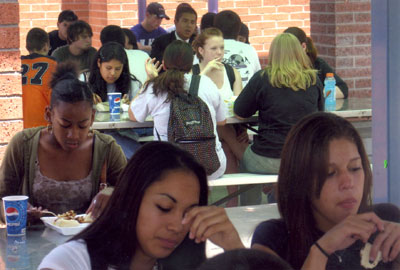All Nonfiction
- Bullying
- Books
- Academic
- Author Interviews
- Celebrity interviews
- College Articles
- College Essays
- Educator of the Year
- Heroes
- Interviews
- Memoir
- Personal Experience
- Sports
- Travel & Culture
All Opinions
- Bullying
- Current Events / Politics
- Discrimination
- Drugs / Alcohol / Smoking
- Entertainment / Celebrities
- Environment
- Love / Relationships
- Movies / Music / TV
- Pop Culture / Trends
- School / College
- Social Issues / Civics
- Spirituality / Religion
- Sports / Hobbies
All Hot Topics
- Bullying
- Community Service
- Environment
- Health
- Letters to the Editor
- Pride & Prejudice
- What Matters
- Back
Summer Guide
- Program Links
- Program Reviews
- Back
College Guide
- College Links
- College Reviews
- College Essays
- College Articles
- Back
Feedback on
The article “The Oceans Between Us,” written by Eugenia Lee in the November 2018 issue, discusses the presence of cliques and stereotypes among teenagers today. In the article, Eugenia draws a comparison between teenagers and finches living in the Galápagos Islands. Eugenia explains how these finches all originated from a single species, but due to adaptive radiation, diverged into 13 different sub-species, each living on different islands with different features and mating songs to prevent separate species from intermingling. She goes on further to say that this sort of behavior is present in teenagers all over the world, in the form of cliques and exclusive friend-groups. However, Eugenia explains, these cliques are what lead to stereotyping and assumptions because other people can only make conclusions about you based on how you present yourself.
I found this article very eye-opening and insightful. I particularly found interesting the example Eugenia gives about her own school cafeteria. Eugenia describes how at the cafeteria, “the tables and booths are like little islands where cliques segregate themselves.” She tells about the “gamers and obsessive academics,” the “exclusive, brand-name teens,” “the garrulous groups,” and “the two Asian tables: one for guys and one for girls.” I was able to draw a parallel between Eugenia’s cafeteria and my own. The more I thought about it, the more I realized that I personally have experienced these cliques. At my school, the same groups of kids sit at the same tables - the jocks with jocks, nerds with nerds, popular teens with popular teens, video-game fanatics with video-game fanatics, etc. I never gave it much contemplation. I just thought, “This is the way things are, and there’s nothing we can do about it.” But Eugenia’s article made me reconsider. She shares a personal anecdote in which one day, at the Asian girl table at which she sat, a teacher came over and inquired the whereabouts of an Asian girl. Eugenia and her friends politely responded no, and the teacher left without asking any other tables. The following week, the same teacher returned to Eugenia’s table, and asked once again if they knew where the Asian girl was. The students again said they didn’t know, only this time, Eugenia was fuming. She says she was about to boil over in rage because she believed the woman to be ignorant, but then “realized that my friends and I were just as much a part of the problem as the teacher was.” Eugenia explains that it was only “natural to assume that this girl would sit among the Asians, as our behavior seemed to communicate as much.”
This was what stood out to me. Eugenia made me realize that stereotyping is a direct product of exclusive friend-groups. By only associating with the people you are similar to, you cause others to build assumptions based on the group, not based on the individual. In order to truly be treated equally, you have to exit your comfort zone and spend time with other people. Or, as Eugenia put it, “Instead of staying in the comfort of our islands, teens should be more open to sitting with other friends.” There are other people out there who may not look the same as you, but still have the same interests and derive their happiness from the same sources.
Eugenia Lee wrote a fantastic article and provided insightful commentary on how cliques lead to false assumptions. I agree with her statement that the obstacles between different teens are nonexistent. We do have a choice, and we can choose to fly to other islands and create friendships regardless of appearance.

Similar Articles
JOIN THE DISCUSSION
This article has 0 comments.
